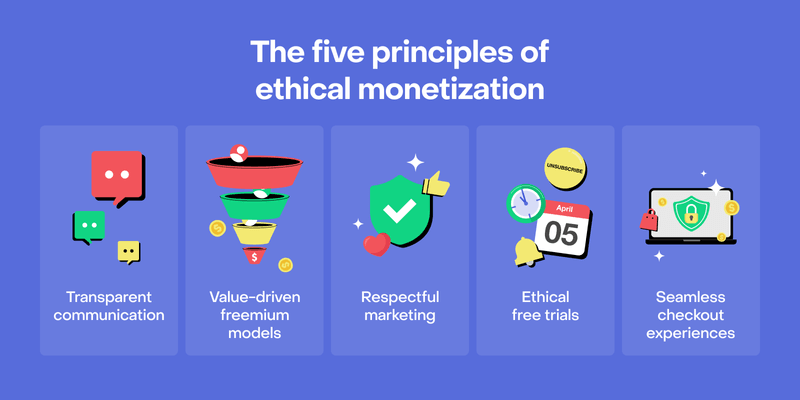Is monetization hurting your app’s user experience?
Don’t trade short-term revenue for long-term trust. How ethical UX can still drive effective monetization.

Monetization is the pinnacle of any subscription app’s growth strategy. However, when revenue generation is prioritized at the expense of the user experience, it can do more harm than good. To avoid harmful practices, app developers and marketers should balance user experience and revenue generation – which is no easy task. In some cases, what is appropriate for one app or product could be harmful when implemented in another.
Here are some basic principles to follow to ensure you’re getting the balance right:
- Transparent communication: Make pricing, trial periods, and subscription details clear and easy to understand.
- Value-driven freemium models: Provide enough free value to build trust and encourage users to upgrade willingly.
- Testing & feedback: Regularly gather user feedback to optimize the monetization approach without disrupting user experience.
- Respectful marketing: Offer premium options as enhancements rather than coercive necessities or remove the free experience entirely if it isn’t really free.
This article will explore common monetization mistakes, explain why they can harm the user experience, and provide actionable strategies to optimize revenue generation while retaining users.
Deceptive dark patterns are a no-go
Using misleading buttons or confusing navigation to push users toward paid actions creates resentment as it often manipulates users into actions they might not have taken willingly, such as unintended purchases, subscriptions, or data sharing. Not only do these tactics hurt your reputation with users, the US Federal Trade Commission and other governing bodies are cracking down on this.
Amazon has faced criticism, in the past, for making its subscription cancellation process overly complicated, requiring users to answer many questions before cancelling. And for using “confirmshaming”, whereby specific language is used to guilt users into maintaining a subscription they’re trying to cancel.

Collecting data on why users cancel and continuously analyzing your value proposition is always a good idea. Additionally, a more ethical way to convince users not to unsubscribe would be to remind them of the benefits they would miss out on when they cancel or downgrade to a free tier. Amazon’s most up-to-date unsubscribe UX incorporates this.

Avoid constantly interrupting content with Ads
Ads can be a great way to make products more accessible with free or affordable pricing plans. Keep in mind that users will expect Ads in some products where it has become the norm to display them (e.g. content consumption platforms like Instagram, TIkTok, and Hulu, where they are seen as a fair trade-off for free access), while there are other products where Ads may come across as intrusive or downright inappropriate. For example, productivity, finance, or high-quality journalism. Bombarding users with too many ads, especially unskippable, overly long ones, or ones that disrupt a piece of content, can create frustration for users and come across as spammy or distrustful.
In 2020, Google removed over 600 apps from the Play Store for violating policies on disruptive Ads. These apps, including some news applications, were found to bombard users with full-screen Ads and engage in Ad fraud, highlighting a broader issue within the app ecosystem.
An effective approach to subscription conversion is leveraging “no ads” messaging as a compelling value proposition, particularly when presented through well-timed in-app messages. Successful platforms like YouTube and Spotify demonstrate this strategy effectively by offering users an Ad-free experience through paid subscriptions, striking a balance between providing value and generating revenue. For apps that choose to offer free content, it’s crucial to place Ads in a way that feels contextual and doesn’t interrupt the user experience. By thoughtfully integrating Ads or positioning Ad-free experiences as a premium benefit, apps can drive higher subscription conversions.

Keep in mind that while Ads can be a great way to monetize users who won’t commit to a subscription, this tactic only works if you have a compelling value proposition on the free tier. Artificially limiting the free experience to the point of making the app unusable is a recipe for churn. Apps that offer useful free tiers, while clearly communicating the benefits of upgrading, are more likely to convert users. Alternatively, it’s better to make it clear from the get-go that your app is subscription-based in order to set clear expectations.
Creating unnecessary barriers to accessing content, such as bandwidth throttling for free users, can alienate audiences. Apps that provide clear value through free access while highlighting premium benefits perform better.
If you’re going to use high pressure tactics, make sure they’re genuine
Countdown timers that reset upon page refresh are a classic example of false urgency. Similar to messaging that says things like “running low” or “only one room left on our site”. E-commerce and travel booking platforms using fake scarcity messages often lose credibility once users catch on to the tactic. Genuine urgency, like seasonal sales or limited-time offers, feels more authentic and effective. Similarly, displaying inflated original prices to make discounts seem appealing is a common tactic in e-commerce apps. Users increasingly recognize when these discounts are fake, and the tactic ultimately erodes brand trust.
Situations where high-pressure tactics could (sometimes) work would be, for example, using countdown timers in onboarding and then offering a reward for onboarding completion (e.g. 10% off your first year’s subscription if you complete onboarding in under 5 minutes) can be a nice way to improve onboarding completion rates while rewarding users for their commitment. This approach prioritizes rewarding and incentivising users over manipulating them into doing something they might regret.
Be careful with the way in which your product presents a “free trial”
Due to Apple and Google’s “auto renewable” subscriptions, most apps will require users to authorize their payment details (e.g. through Apple or Google Pay) at the beginning of starting their free trial. However, apps that promote “free trials” without making auto-renewal terms clear can cause frustration when users are unexpectedly charged. This has led to the phenomenon of users immediately going into their settings and cancelling their subscriptions, before they’ve even started the trial. To combat this, some apps layout clear terms in their paywall screens, reassuring users that they will be reminded when their trial is about to end.
Subscription-based learning platform, Blinkist, became well-known for being one of the first apps to lay out their free trial terms and follow-up with users to remind them when their trial ends. Many apps have since copied this in the hopes it will increase subscription conversion. However, the true value of this tactic is enhancing brand and user trust.
Automatically renewing subscriptions without sending reminders has been a major source of complaints. Platforms like Audible have faced criticism for enrolling users into ongoing plans without adequate warnings.

Avoid requesting card details before users try core features (unless your product’s value proposition focuses on urgency)
Requesting payment details upfront can work well for apps where users expect immediacy and efficiency, like mobility, food delivery or ride-sharing apps. These apps prompt users to enter payment details during onboarding because their value proposition is tied to urgency — users download them to complete tasks quickly, and removing friction at the moment of purchase enhances the user experience. Established brands can also get away with this approach due to high trust levels.
However, for apps relying on subscriptions, content consumption, or habit formation (e.g., learning, wellness, productivity), asking for payment details too early can drive users away. High drop-off rates occur when users haven’t experienced enough value to feel comfortable providing payment information.
To avoid this, apps can offer guest access, limited trials, or freemium models to showcase value before introducing a paywall. Apps like Calm and Headspace use free introductory sessions to build user trust. Ultimately, the timing of payment requests should align with user expectations and the product’s value proposition.
Pay-to-progress models have received criticism in gaming
Mobile games that rely heavily on pay-to-progress models (such as Dungeon Keeper Mobile) have received backlash for creating artificial difficulty to encourage microtransactions. On the other hand, games that use monetization strategies focused on cosmetic items (e.g. Fortnite), non-essential features, or optional enhancements, instead of progress-blocking purchases, are generally better received.
Games should be enjoyable for all users, not just paying customers. Ensure progression systems reward skill and effort rather than just financial investment.

Aggressive in-app messages hurt conversion
In-app messages that constantly prompt users to upgrade or purchase premium plans create a negative perception of their services. LinkedIn, for example, displays upgrade messages frequently, which can feel pushy. A more effective approach would be to show upgrade prompts when users are close to hitting the limitations of the free tier (e.g., reaching the monthly limit on profile views or InMail messages).
Grammarly’s free version consistently displays upgrade prompts when users try to access premium writing suggestions. However, the prompts are triggered by user actions (e.g., trying to access advanced suggestions) rather than appearing randomly. This contextual approach ensures that users are more receptive to upgrading since they actively see the value of the premium features.
Users often interpret constant prompts as a sign of desperation, suggesting that the app cares more about monetization than delivering a valuable experience. When messages are too frequent or disruptive, they create frustration and erode user trust.
Interruptions during critical moments (e.g., while composing a message, during meditation, or while engaging with content) are particularly damaging.
Users become desensitized to repetitive messages, leading to “banner blindness” where they ignore all prompts, including potentially useful ones.
Unclear value propositions confuse users
When apps don’t clearly communicate the benefits of their premium features, users feel tricked. For example, some streaming apps display a “premium-only” label without explaining what makes the content superior. Providing free samples or detailed descriptions can help users understand the value proposition.
Utility apps like Evernote and Notion successfully differentiate their free and premium tiers by specifying features like offline access, advanced sharing capabilities, or higher upload limits.
Similarly, Language-learning apps that label certain lessons as “Pro” but don’t specify how they differ from free content often struggle to attract subscribers. Apps like Duolingo avoid this issue by providing detailed comparisons showing that Duolingo Plus offers ad-free learning, progress tracking, and offline courses.
An additional note:
Make sure, if your checkout is on the web, that it’s easy to be redirected from mobile.
If your app’s checkout process occurs on the web rather than within the app itself, it’s critical to ensure that users can easily transition from their mobile devices to the web. Poorly executed upsell messaging that doesn’t deep-link properly or direct users to the correct web pages can severely harm conversion rates.
Spotify famously moved its premium subscription checkout to the web (likely to avoid paying a 30% commission to Apple’s App Store). However, in-app messaging and upsell prompts lacked deeplinks that would directly take users to the web checkout page. Instead, users are forced to navigate to the payment page manually. Redirecting users to web checkout requires precision. Including deep links and making sure the web experience is mobile-optimized are essential steps to maintain conversion rates.

To summarize, monetization doesn’t have to compromise user experience. Following these five principles for ethical monetization will help you build trust, long-term retention and drive revenue effectively:
- Transparent communication: Clearly present pricing, trial terms, and cancellation processes. Avoid misleading messaging by using straightforward, honest language.
- Value-driven freemium models: Provide real value in your free tier to build user trust and encourage upgrades. Avoid artificially limiting the free experience to force subscriptions.
- Respectful marketing: Use upsell messaging that highlights genuine benefits, avoiding guilt-tripping or fake urgency. Let users experience value before asking for payment details unless urgency is essential.
- Ethical free trials: Make auto-renewal terms clear from the start and provide timely reminders before charges occur. This approach enhances trust and minimizes frustration.
- Seamless checkout experiences: Ensure all purchase links work correctly across platforms and are optimized for mobile. Use deep links and mobile-friendly pages to reduce friction.
You might also like
- Blog post
Meta Ads in 2025: Expert tips from Marcus Burke
Marcus Burke discusses AI, UGC, and the lifespan of ad creatives.
- Blog post
The creative testing system that slashed our CAC (and scaled our spend)
We scaled Meta ad spend by 74.6% and dropped CAC 40%. Here’s how.
- Blog post
Building a lovable alien and a $1M ARR AI app
Ajay Mehta explains how smart monetization and standout characters helped Tolan cut through the AI hype.

